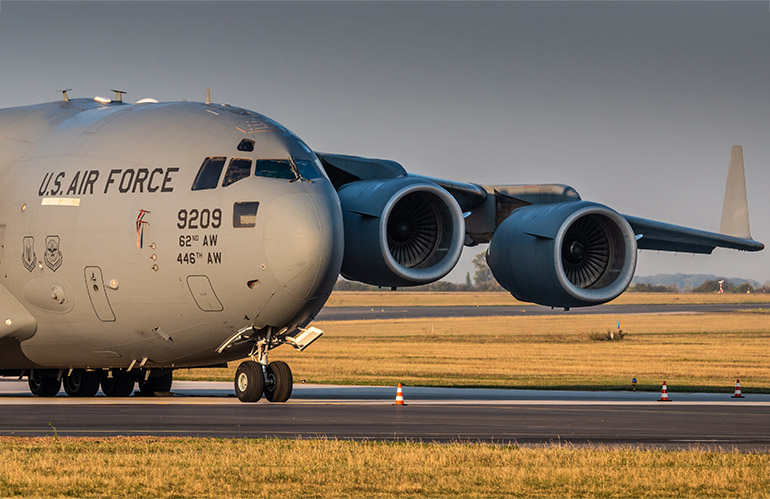|
Listen to this article |

A Boeing C-17 Globemaster III military transport aircraft. Palladyne AI is continuing to validate its industrial robot software for media blasting of complex aircraft components. Source: Adobe Stock
Robots and the latest software to control them are becoming essential to aircraft maintenance in both the civilian and defense sectors. Palladyne AI Corp. today announced that it has completed Phase I of its multi-million-dollar contract with the Air Logistics Complex at Warner Robins Air Force Base in Georgia.
Phase II will continue integration and use-case validation of the Palladyne IQ software for use in remediation activities including media blasting for complex aircraft components. This is the second year of a planned four-year effort valued at $13.8 million.
The competitive Strategic Funding Increase (STRATFI) program selected Palladyne AI for the contract. STRATFI came out of the U.S. Air Force’s AFWERX AFVentures innovation incubator.
Software supports curved surface prep
In Phase II of the contract, the Air Force will use Palladyne IQ software to prepare complex, high-value aircraft components of varying types and sizes. It will use detection, identification, and surface mapping to maintain the correct distance and angle for optimal application of surface-preparation materials.
“The Palladyne AI software is a transformational technology that will benefit both commercial and Department of Defense industrial and maintenance automation advancements,” said Shane Groves, a robotics expert at Warner Robins Air Logistics Complex (WR-ALC).
“The software has successfully shown the ability to autonomously prepare contoured surfaces using sanding and media-blasting techniques and has delivered high value to our repair and maintenance operations in a short amount of time,” he said. “I have no doubt that this critical work will deliver long-term benefits for Warner Robins Air Logistics Complex industrial automation and productivity.”
“The U.S. Air Force continues to broaden access to disruptive technologies through their support and engagement with emergent technologies and novel commercial solutions,” said Ben Wolff, president and CEO of Palladyne AI. “We look forward to this continued partnership to advance our Palladyne AI autonomy software with agility, focus, and speed to automate dull, boring, and dangerous tasks that have historically been too challenging and complex to automate.”
Palladyne continues pivot to enabling robot autonomy
Formerly known as Sarcos Technology and Robotics Corp., Palladyne AI has pivoted from teleoperated robotics to software and artificial intelligence for industrial automation in unstructured environments. The Salt Lake City-based company rebranded in March but has continued its defense business under the Sarcos Defense brand.
At the time, Wolff said: “This rebranding is not just a change in name, but a reflection of our commitment to delivering a fundamentally superior type of intelligence for both mobile and stationary robots by enabling robots to observe, learn, reason and act in a manner akin to humans, which enhances robot versatility, substantially shortens robot training time, and materially reduces power required for AI processing.”
Last week, Palladyne AI announced that it is providing its Pilot sensor-fusion software to Red Cat Holdings Inc.‘s drones. The partners said they plan to create a network of collaborating drones and sensors that self-orchestrate to provide intelligence, surveillance, and reconnaissance capabilities.
“Palladyne AI is enabling cost-effective small drone platforms that incorporate some of the same autonomy capabilities typically only found on large drone platforms costing tens of millions of dollars,” said George Matus, chief technology officer at Red Cat.
“Their Palladyne Pilot autonomy software provides our drone systems with generalizable autonomy that enables a high level of adaptability and performance in challenging environments, materially reducing the cognitive load on drone operators and enhancing the operational capabilities and mission effectiveness of our drone platforms,” he added.
Editor’s note: At RoboBusiness 2024, there will be a Field Robotics track, including a panel discussion on how to overcome the challenges in designing outdoor systems.

